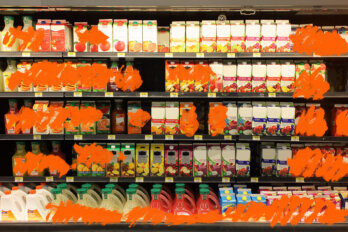Sometime in the seventeenth century, during military operations in the Netherlands, British soldiers came across a particularly strong juniper-flavoured Dutch spirit called genever. When they brought it back to the homeland, it quickly became the drink of the masses—easy to produce and cheap to access. What followed was the “gin craze” of the 1600s and 1700s, an epoch in Britain marked by a boom in gin manufacturing, consumption, and, eventually, its regulation.
By the nineteenth century, gin was becoming known as a British classic. The spirit had cemented its reputation and identity with iconic styles like London Dry Gin, enjoyed in well-known serves like the gin and tonic, a colonial innovation used to combat malaria in India. (Quinine, which is responsible for the bitter taste in tonic water, has anti-malarial properties—though nowadays, with the reduced quinine content in tonic water, you’d have to drink around seventy litres of it per day for it to have that effect.)
In his 1953 novel Casino Royale, Ian Fleming gave us one of the most recognizable gin-based drink orders. Named after one of James Bond’s femme fatales, Vesper Lynd, the Vesper martini came with a clear recipe, starting with a British gin: “Three measures of Gordon’s, one of vodka, half a measure of Kina Lillet. Shake it very well until it’s ice-cold, then add a large, thin slice of lemon peel. Got it?” says Bond.
I definitely got it. It is, without a doubt, my favourite cocktail. But during a restocking trip at the Société des alcools du Québec—SAQ—last year, I was surprised to learn that there was such a thing as Quebec-made gin. And I was simultaneously dismayed to find out that the Crown corporation, a monopoly that generates over $1 billion annually for the province, was cutting shelf space devoted to it.
Last April, the SAQ announced it was removing roughly 150 spirit products from store shelves by the end of the year (at the time of the announcement, the organization had over 600); 35 to 40 percent of those products were slated to be Quebec-made gins.
The SAQ’s mandate is to sell alcohol throughout Quebec. Since it has exclusive control over the sector, local distilleries are always at its mercy. When the SAQ decided to start reducing shelf space devoted to local gin last spring, it didn’t just mean Quebecers like me would have fewer options; it also meant small distilleries were in big trouble. While the SAQ did not specify the number of affected distilleries, a flurry of media coverage at the time quoted owners complaining about the decision. Some said the shrinking of shelf space would limit their primary sales channel.
“The SAQ is reactionary. They don’t really have long-term vision,” says Paul Cirka, president of Montreal-based Cirka Distilleries, which specializes in grain-to-bottle spirits. “And small producers in this province have no way of convincing the SAQ that we should be in 100 stores or 150 stores; they decide. And they’ve been pretty tough.”
Between 2019 and 2022, sales of Quebec-produced spirits, including gin, surged by 75 percent—a trend the SAQ breezily promoted. “Every trend in Quebec, whether if it’s alcohol, clothing, decoration design, we are way closer to the European market than any other province in Canada,” says Simon Bourbeau, account director of supply management at the SAQ. “Gin being popular at the time . . . that’s why [Quebec] jumped into it.” He says people felt the appeal especially during the pandemic.
The SAQ didn’t explicitly stipulate that distillers needed to pivot to gin. But to some, the buzz created a free-for-all effect. “With the lack of regulations, that in itself is fundamentally an encouragement to ‘Give us whatever you have,’” says Cirka. “So, everybody looked at the trend and thought, ‘I can do this.’ Until it got out of hand.”
At the time, the few local distilleries producing Quebec gin—Romeo’s Gin, Ungava Gin, Km12, BleuRoyal Gin—also contributed to the hype. It helps that gin isn’t complicated to produce. It’s made by distilling a neutral-grain alcohol, like fermented wheat or barley, with juniper berries and optional ingredients, such as coriander seeds, cardamom, angelica root, or citrus peels.
In Quebec, new and established gin makers have been infusing their drinks with local plant extracts, herbs, or spices, like birch bark and maple sap. Ungava Gin, for example, uses wild rose hip, Labrador tea, and crowberry, which are typically found in northern Quebec’s Arctic tundra. And according to SAQ financial reports, this formula was wildly successful for a while.
The gin spike dovetailed with the rapid growth of Quebec’s micro-distillery industry, which expanded from fewer than a dozen to approximately seventy distilleries over the past decade. Research suggests that Canadians have a preference for artisanal or craft alcoholic beverages. “There’s a romance associated with small and local,” says Vivek Astvansh, associate professor of quantitative marketing and analytics at McGill University. “If [consumers] see that there’s a local distillery that has exerted effort in producing that gin, [they] tend to say, ‘Okay, let me try this.’”
Nicolas Bériault, co-founder of Distillerie 3 Lacs in southwestern Quebec’s Salaberry-de-Valleyfield, suggests that it’s less of a surge in gin appreciation and more of a simple and natural recalibration of the market. During Prohibition, which ended in 1919, Quebecers lost the habit of drinking spirits, and the province leaned more into its love of wine and beer.
“We don’t have that culture compared to Ontarians who are bigger whiskey drinkers, for example. So I think, first, we were very low in our [consumption] habits. And then there’s an international explosion of the gin trend,” says Bériault. “We went through a period of catching up. Many businesses see a big trend and jump in.” Gin’s versatility in cocktails—its complex profile serves as a solid foundation for both classic and contemporary drinks—has made it a growing favourite among home bartenders and mixologists in the past decade, fuelling its popularity in cocktail culture.
Sometimes, however, a trend just stops trending. The peak demand was never going to be sustainable. Bériault notes that, at one point, Quebec had around 450 different local gins. “It doesn’t make sense for a population of a little over 9 million people.”
Mix in a general decline in alcohol consumption and the bottleneck becomes unavoidable. Gen Z are drinking less than previous generations. In a 2023 Statistics Canada report, 67 percent of Canadians aged eighteen to twenty-two said they didn’t have any alcohol in the previous week. In a 2024 Léger survey, 22 percent reported never having consumed alcohol.
Over the past year, Quebecers’ interest in craft gin has waned. Cirka feels the province’s distillers were backed into a corner. “The SAQ, historically, has always taken the approach of ‘We’re just going to throw everything at the wall and see what sticks,’ rather than ‘Let’s set up an initial filter process, evaluate products, and put the best things on the shelf.’”
Even if distillers sell their gins onsite, as part of tasting events, for example, they still have to forward a percentage of those sales to the SAQ. And this, as craft distillers fear, can put a business in serious financial precarity—especially smaller and emerging ones as well as urban ones that, according to Cirka, don’t have the same regional brand loyalty as rural producers.
“Our job is to ease the sales of Quebec products,” says Bourbeau. “Our job is not to make any business plans for them.” He notes that following a trend is always risky and that it is a company’s responsibility to do market research. “What we did at the SAQ is say, ‘Hey, this is a positive context to introduce new products. The sales are there.’ But we didn’t say produce more gin than whiskey or more vodka. We didn’t say it must be gin. It’s really their business plan. And we respect every business plan in Quebec.”
Provinces that rely heavily on alcohol revenue—like Quebec, Ontario, and British Columbia—have little choice but to factor in changing behaviours. The SAQ, for example, is tapping into the sober-curious movement and selling non-alcoholic beverages. In 2022, Quebec senator Patrick Brazeau, who has struggled with alcohol abuse, presented Bill S-254, which requires health labels on all alcohol bottles to clarify the causal relationship between alcohol and cancer.
In light of the current escalating trade tensions with the United States, the provincial government ordered the SAQ to remove all US-made alcohol from its store shelves, a move that Cirka feels is just for show. “Obviously, we don’t like what America is doing,” he says. But the SAQ, he adds, is “not saying, ‘Hey, we have empty shelves. Let’s go to our Quebec producers and go—what are your plans for the next six or twelve months in terms of production? Let’s fill those [shelves].’ We haven’t heard from the SAQ about this, and I don’t think we will.” In an email, Bourbeau said stores are replacing American products with Canadian ones but that there weren’t many American gins to begin with, “so the effects might be less exceptional for this particular category.”
So where does that leave smaller distilleries? Though a controlled market often prioritizes the volume, consistency, and profit margins that come with bigger foreign brands, moments of imaginative alchemy will still find a way. They might be rarer and more fleeting, but spirit producers in Quebec do what they do for reasons beyond revenue. As Bériault puts it, “We are a passionate people. To be in this industry, you have to be passionate.” Especially if you’re finding innovative ways to make classic spirits feel ben d’icitte—Quebec slang for “from here.”
It’s said that Quebec-made tequila, the latest trend, will be the next flash in the pan. “Do we think about it? Yes,” says Bériault. But at a certain point, as he sees it, you have to simply work at being a master in your own category. And for him, right now, that’s gin.




